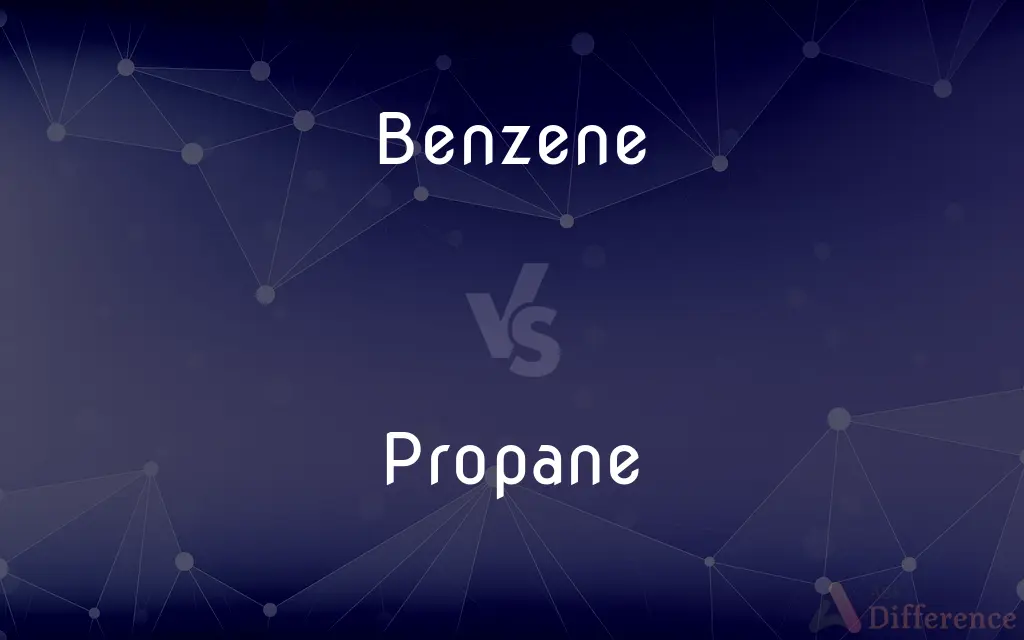Benzene vs. Propane — What's the Difference?
By Maham Liaqat & Urooj Arif — Updated on March 27, 2024
Benzene is an aromatic hydrocarbon with a ring structure, known for its use in chemical synthesis, while propane is a saturated hydrocarbon used primarily as fuel.

Difference Between Benzene and Propane
Table of Contents
ADVERTISEMENT
Key Differences
Benzene, C6H6, features a unique ring structure with alternating double bonds, making it an aromatic compound with significant applications in the production of plastics, resins, and synthetic fibers. Propane, C3H8, on the other hand, is a saturated hydrocarbon, part of the alkane family, used extensively as a fuel for heating, cooking, and in vehicles, due to its high energy content and clean-burning properties.
While benzene is known for its carcinogenic properties, posing health risks upon inhalation or long-term exposure, propane is considered a safe fuel option when properly stored and handled, despite its flammability and potential for explosive combustion under certain conditions.
The production of benzene primarily involves the use of petroleum and coal, through processes such as catalytic reforming and steam cracking, highlighting its dependency on fossil resources. Conversely, propane is obtained through natural gas processing and petroleum refining, making it widely available and relatively inexpensive compared to other fuels.
Benzene's use in chemical industries is attributed to its ability to undergo electrophilic substitution reactions, facilitating the synthesis of various chemicals and polymers. Propane’s utility, however, lies in its role as a portable energy source, especially in areas not served by natural gas pipelines, due to its ease of compression into a liquid form.
Despite their differences, both benzene and propane are crucial to modern industries—benzene as a chemical building block and propane as an energy source. Their applications demonstrate the diverse potential of hydrocarbons, from manufacturing to energy production.
ADVERTISEMENT
Comparison Chart
Chemical Formula
C6H6
C3H8
Type of Hydrocarbon
Aromatic
Alkane
Primary Uses
Production of plastics, resins, synthetic fibers
Heating, cooking, vehicle fuel
Health Risks
Carcinogenic, harmful upon inhalation
Flammable, risk of explosive combustion
Production Source
Petroleum and coal
Natural gas processing and petroleum refining
Chemical Properties
Undergoes electrophilic substitution reactions
Can be compressed into a liquid for easy transport
Environmental Impact
High, due to toxicity and production process
Lower, burns cleaner than other fossil fuels
Compare with Definitions
Benzene
A colorless, volatile liquid hydrocarbon, part of the aromatic hydrocarbon family.
Benzene is used as a solvent in the chemical industry due to its ability to dissolve a wide range of chemicals.
Propane
A three-carbon alkane gas, used as a fuel in heating and cooking.
Many outdoor grills use propane tanks for fuel.
Benzene
Known for its use in the synthesis of industrial chemicals.
Styrene, used to make polystyrene plastics, is produced from benzene.
Propane
Obtained as a byproduct of natural gas processing.
Propane is separated from natural gas in a process called fractionation.
Benzene
Found in crude oil and produced during the refining process.
Benzene is one of the components extracted during the catalytic reforming of petroleum.
Propane
Burns cleaner than many other fossil fuels, emitting less carbon dioxide.
Propane is preferred for indoor heating due to its clean combustion.
Benzene
Carcinogenic and requires careful handling and exposure control.
Industrial workers are advised to wear protective gear when working with benzene.
Propane
Can be liquefied under pressure for storage and transport.
Liquefied propane is stored in cylinders and used for camping stoves and lanterns.
Benzene
Utilized in the manufacture of nylon fibers.
Benzene is a precursor in the production of adipic acid, used in nylon manufacturing.
Propane
Known for its role as a portable energy source.
Propane can be transported easily in tanks for use in areas without natural gas service.
Benzene
Benzene is an organic chemical compound with the molecular formula C6H6. The benzene molecule is composed of six carbon atoms joined in a planar ring with one hydrogen atom attached to each.
Propane
Propane () is a three-carbon alkane with the molecular formula C3H8. It is a gas at standard temperature and pressure, but compressible to a transportable liquid.
Benzene
A colorless, flammable, toxic, liquid aromatic hydrocarbon, C6H6, derived from petroleum and used in or to manufacture a wide variety of chemical products, including DDT, detergents, insecticides, and motor fuels. Also called benzol.
Propane
A colorless gas, C3H8, found in natural gas and petroleum and widely used as a fuel.
Benzene
(organic compound) An aromatic hydrocarbon of formula C6H6 whose structure consists of a ring of alternate single and double bonds.
Propane
(organic compound) An aliphatic hydrocarbon, C3H8, a constituent of natural gas.
Benzene
Sometimes used in place of the phenyl group.
Propane
A heavy gaseous hydrocarbon, C3H8, of the paraffin series, occurring naturally dissolved in crude petroleum, and also made artificially; - called also propyl hydride.
Benzene
A volatile, very inflammable liquid, C6H6, contained in the naphtha produced by the destructive distillation of coal, from which it is separated by fractional distillation. The name is sometimes applied also to the impure commercial product or benzole, and also, but rarely, to a similar mixed product of petroleum.
Propane
Colorless gas found in natural gas and petroleum; used as a fuel
Benzene
A colorless liquid hydrocarbon; highly inflammable; carcinogenic; the simplest of the aromatic compounds
Common Curiosities
How do benzene and propane differ in structure?
Benzene has a ring structure with alternating double bonds, while propane is a linear or branched alkane without double bonds.
What is benzene?
Benzene is an aromatic hydrocarbon, known for its ring structure and applications in chemical synthesis.
Why is benzene considered carcinogenic?
Benzene is carcinogenic because it can cause changes in the DNA within cells, leading to cancers such as leukemia.
How is propane obtained?
Propane is obtained through natural gas processing and petroleum refining.
What are the primary uses of benzene?
Benzene is primarily used in the production of other chemicals, plastics, resins, and synthetic fibers.
How do the environmental impacts of benzene and propane compare?
Propane has a lesser environmental impact compared to benzene, especially in terms of air quality and health risks.
What is propane?
Propane is a saturated hydrocarbon used mainly as a fuel for heating, cooking, and in vehicles.
Are benzene and propane environmentally friendly?
While both are fossil fuels, propane burns cleaner than benzene and is less harmful to the environment due to lower emissions.
What are the primary uses of propane?
Propane is primarily used as a fuel for heating, cooking, and as an alternative fuel for vehicles.
Can benzene and propane be used interchangeably?
No, due to their different chemical properties and applications, they cannot be used interchangeably.
What makes propane a popular choice for heating and cooking?
Its portability, high energy content, and clean-burning properties make propane a popular choice.
What precautions should be taken when handling benzene?
Use protective equipment, ensure adequate ventilation, and follow safety guidelines due to its carcinogenic nature.
Is propane safe for indoor use?
Yes, when used with proper ventilation and safety measures, propane is safe for indoor use.
Can benzene be found in everyday products?
Yes, benzene is used in the manufacture of many everyday products, including plastics, resins, and synthetic fibers.
How are benzene and propane produced?
Benzene is produced from petroleum and coal, while propane is produced from natural gas processing and petroleum refining.
Share Your Discovery

Previous Comparison
Hitch vs. Wed
Next Comparison
Automatic vs. AutomationAuthor Spotlight
Written by
Maham LiaqatCo-written by
Urooj ArifUrooj is a skilled content writer at Ask Difference, known for her exceptional ability to simplify complex topics into engaging and informative content. With a passion for research and a flair for clear, concise writing, she consistently delivers articles that resonate with our diverse audience.
















































